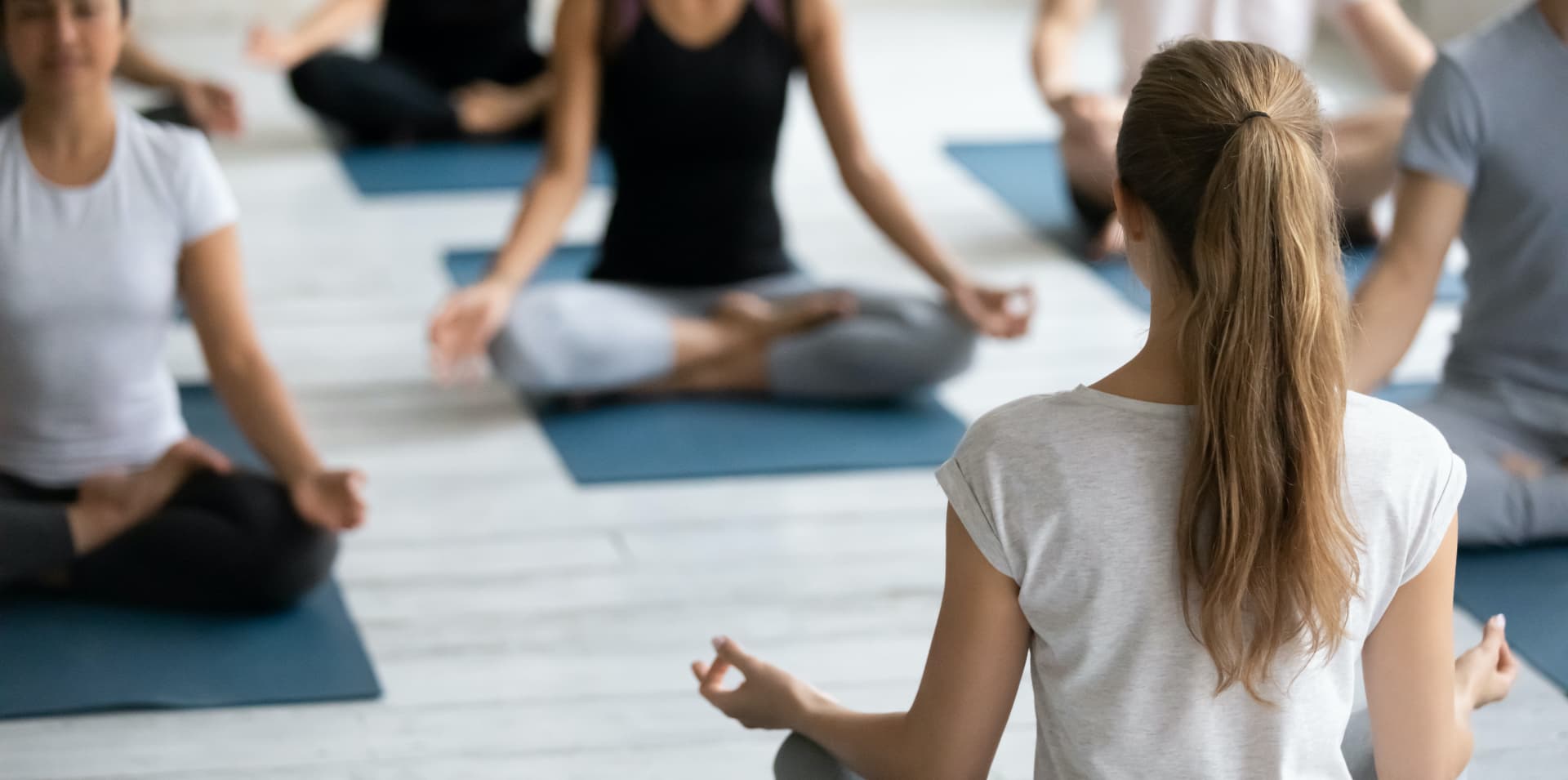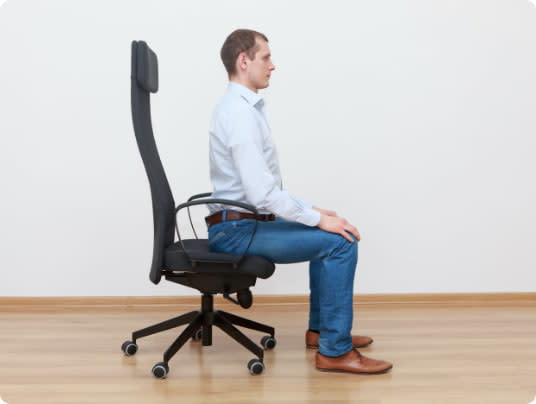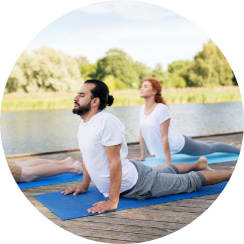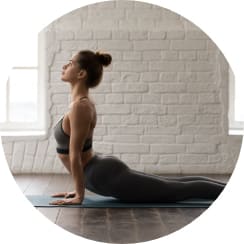
The Complete Guide to Improving Your Posture
Our posture influences our health and well-being in more ways than most people realize. Good posture generates physical benefits such as improved sleep and a strengthened core, as well as mental benefits including increased focus and productivity. At Upright Pose, good posture is our only focus. Join us to learn why posture is important, how it affects your life, and what you can do to achieve your best posture.
-
The Role Posture Plays
in Our Daily Lives - What is Good Posture?
- What is Bad Posture?
- The Dangers of
Prolonged Poor Posture - Different Kinds of Posture
- Benefits of Improved
Posture - How to Improve
Your Posture - Home Exercises to
Improve Neck, Shoulder,
and Back Posture - How to Know Your
Posture Has Improved - Build on Your Foundation
— The Mind-Body Connection
to Good Posture

The Role Posture Plays in Our Daily Lives
Posture has everything to do with our lives. Just like breathing is something we do organically, our daily posture habits greatly affect our health and well-being. It is true that our posture can even affect our long-term health. We’ve all had a loved one nag us to stop slouching or sit up straight, right? Well, it turns out there’s more to standing up correctly than just looking confident, which, by the way, is another positive benefit of good posture!
Good posture can alleviate back pain, stimulate muscle mobility, prevent muscle strain, and reduce impact and stress on the bones, joints, and ligaments. Bottom line? Good posture is extremely important to your overall health.
Why Put So Much Focus on Good Posture?
Why not slouch when relaxing after a long day? Posture affects multiple facets of overall health, for better or worse. Along with the general younger and slimmer appearance good posture can give, it also helps prevent back, neck, and shoulder pain. When your body isn’t aligned correctly, it creates extra strain in areas that aren’t equipped to support your weight.
Imagine holding a bowling ball directly in front of you with one arm. How long could your arm stay strong before the weight of the bowling ball starts to wear you down? A forward-leaning, overbalanced head can put stress on your neck in a similar way, leading to tight, stiff muscles and chronic pain.
Posture affects more than visible physical health. Upright posture allows for better oxygen flow into and through your body, which improves the function of every organ, including your brain. While poor posture is linked to various issues, including poor confidence and increased depression, an upright posture can give an emotional boost and support positive mental health. Simply standing or sitting up straight could be the best gift you can give your body.

What Is Good Posture?
Posture involves the alignment of the spine and neck. Essentially, it’s how we stand, sit, or lie down. That’s right — you can have good posture while you sleep, too! Good posture doesn’t revolve around simply sitting upright. It is connected to muscle tension and gravity. In short, we use muscle tension to hold our bodies in an upright position, so that the weight of gravity doesn’t let us slump down to the ground. Improving our posture takes funneling our focus into our body. Some of the body’s postural muscles automatically help us stand or sit upright; however, others need a little coercion. Not only does alignment equate to good posture — it also helps create balance and mobility.
What Does Good Posture Look Like?
Most people think that correct posture means standing with their pelvis tilted backward or forward in an exaggerated manner. They may crane their neck forward or over-straighten it, which can cause serious damage. As a rule of thumb, your pelvis should be in line with your ribcage, with your head comfortably balanced atop your spine. A key is to avoid pulling or pushing your body in any direction that feels unnatural. Doing so can hurt your posture and breathing, and make you look and feel ill at ease.
To check if you’re doing it right, stand with your back against the wall, abs tucked in, and head facing forward. If the back of your head and shoulder blades are touching the wall, you’ve got this!
When you see someone with good posture, you know it immediately. Take professional singers for example. One of the first things you learn as a singer is breathing technique. While this is an undeniably important aspect of the craft, proper singing posture is no less critical. Having correct body alignment is key to optimal breathing and may lead to better singing.
It’s basic anatomy. Good posture opens up your chest cavity, maximizing space for your lungs to fully expand and take in more oxygen. If you keep your chest elevated and take low, diaphragmatic breaths, the air gets released more slowly. This is how singers can belt out those long, impressive phrases without running out of breath.
The way you hold your body also affects your ability to produce sound. If any part of you is too tense, you’ll have trouble hitting certain notes. To release tension, ensure that your frame is in perfect alignment, paying particular attention to the position of your neck. Keep it nice and straight, as this allows air to pass unobstructed through your vocal cords. Gently lower your shoulders as if you’re trying to move them as far away from your ears as possible. Let your arms hang loose at your sides. Remember — you’re aiming for a stance that’s relaxed and neutral, as opposed to stiff and restricted.
Benefits of Good Posture
It may seem like straightening up won’t really make a difference in your life. But the benefits of good posture are many. They include:

Better breathing

Increased self-confidence

Back pain relief

Happier moods

Better digestion

Improved concentration
Those are just some of the benefits of postural improvement, but you can also bet that you’ll feel better, look better, and move better when you make it a focus.



What Is Bad Posture?
Bad posture, medically known as postural dysfunction, is when the spine is curved or bent in unnatural positions, putting stress on joints, muscles, and vertebrae. Over time, muscles form a “memory” of the bad positions, which makes it uncomfortable and painful to retrain muscles back into correct positions.
What Does Bad Posture Look Like?
If you want to know if what bad posture looks like, there are few signs to look for, including:
- Slouching
- Rounded shoulders
- Head forward and not aligned with the spine
- Hunched back
- Arching lower back
- Locked knees
- Potbelly
The Dangers of Prolonged Poor Posture
There are many dangers of having prolonged bad posture, most of which relate to physical health.
Long-term issues can include:
Chronic whole-back pain
Frequent pinched nerves
Cervical spine problems
Developing a humpback (Kyphosis)
Neck pain
Recurring
headaches
Sleep issues
And more
Different Kinds of Posture
Our bodies are constantly in motion, so it makes sense that we would have different postures when we are in different positions. Let’s look at the different types of posture, so you can get an idea of the right position for each one.

Standing Posture
- Keep weight mainly on the balls of your feet
- Have knees slightly bent
- Place feet about shoulder-width apart
- Stand straight with shoulders pulled back and down
- Tuck stomach in
- Keep head level (earlobes in line with shoulders)

Sitting Posture
- Keep feet on the floor, when possible
- Don’t cross legs at knees or ankles
- Maintain a small gap between the chair seat and the back of the knees
- Keep knees in line with, or just below, hips
- Adjust the seat for lower back support
- Relax shoulders
- Have arms parallel to the ground

Sleeping Posture
- Use a mattress with comfortable firmness
- Pillows should keep the head in line with the spine
- Sleep on back, if possible, with a small pillow behind the knees
- Avoid contorted positions as much as possible
Good Posture for Men and Women
Posture recommendations are the same for men and women. Good posture is good posture, and everyone should be working toward straightening up. However, although good posture is the same, men and women do encounter some different situations that can cause poor posture.

Common Pitfalls of Posture for Men
Men tend to push themselves harder in physical activities and work through injuries instead of giving themselves time to rest. Continually working through pain causes other muscles to tense up and creates additional pain, which can lead to slouching.

Common Pitfalls of Posture for Women
For women, one cause of poor posture can come from fashion choices. High heels, extremely tight clothing, low-waisted jeans, and more, temporarily change a woman’s center of gravity, but, with prolonged and continuous wear, the change in gravity leads to posture problems as other muscles have to compensate to keep the woman upright.
Benefits of Improved Posture
Learning how to get better posture has immense benefits, with immediate and long-term health results. That’s why it’s important to turn good posture into a habit now. The great thing about posture is that it can be trained. With practice and small lifestyle changes, you’ll improve your posture and be sitting upright naturally without giving it a second thought.
Good posture does many things for your overall health, including:
1. Building Muscle Strength
A large component to maintaining an upright posture is to strengthen the core and back muscles. Movement engages the muscles, in effect building muscle strength. Incorporate daily core exercises, which are particularly helpful at strengthening the postural muscles that insulate and protect the spine.
2. Keeping Organs in Perfect Harmony
Ever experienced the misery of acid reflux, heartburn, or constipation? Believe it or not, all three could be connected to poor posture. Think about it. When we slouch forward, we’re compressing our internal organs into our abdomen like an overstuffed suitcase. The best way to aid digestion and keep things moving along is to adopt correct body alignment.
3. Relieving Upper-Body Tension and Pain
Newcomers to the world of posture training often experience aches and pains when starting to adjust their alignment. This is to be expected, as their muscles are resetting their body to its natural state, engaging muscle groups that probably haven’t seen much activity in a while. But, that burn you’re feeling just means that your new posture is taking shape and you’re building muscle memory. After a week of training, even chronic upper-body pain should subside, making upright posture far more comfortable.
4. Increasing Brain Function and Concentration
With so many distractions in our lives, it can be hard to concentrate on all the tasks at hand. This is especially true when our body is hunched over as we’re restricting the flow of oxygen to our brain. It stands to reason that the more relaxed and successful we feel, the better equipped we are to solve problems. A study by Colorado College found that male students with the best sitting posture significantly outperformed those who slouched in exams. This gives new meaning to straight-A students!
5. Building Natural Confidence
You’d be forgiven for thinking that achieving the perfect beach body is a more important pursuit than correcting body alignment. But, what’s the point in having a great physique if it’s hidden from the world by closed-off posture? Even if you aren’t built like a Greek god or goddess, upright posture can at least give you the appearance of one. By simply carrying yourself with pride, you project the confidence necessary to succeed in your personal and professional relationships. Oh, and FYI, perfect body alignment is totally something to be proud of.
Make Good Posture a Habit to Live By
We’re not suggesting good posture is a cure-all; rather, it is an effective way to invite daily well-being into your life. To truly set ourselves up for optimal performance and life-long habits that foster health and wellness, we need to learn how to make good posture a habit.
There are many opportunities to improve your posture daily. In fact, learning how to make good posture a habit requires small changes every day. The important thing to acknowledge is that you’re here, actively working on your posture and improving your daily well-being. Bravo!
Get In the Habit of Moving to Improve Your Posture, Feel Better, and Get Healthier
Let’s face it — many of us live somewhat sedentary lives due to a variety of contributing factors: work, injuries, etc. Posture training while working, exercising, and moving is a great way to turn good posture into a habit. Whenever you exercise or stretch, it’s important to maintain an upright posture.
With a little movement, we can circumvent sedentary behaviors and shake things up to improve posture and overall health. The benefits of movement include building muscle strength and improving mental clarity and focus. What’s more, movement keeps the body activated and bolsters good posture.
Movement Improves Focus, Mental Clarity, and Moods
When we move, we’re engaging and stimulating ourselves physically, mentally, and emotionally. For example, movement is a mood-booster proven to spark joy and happiness. What’s more, that healthy flow of oxygen clears the head and stimulates mental clarity. With so many distractions in our lives, at times it can be hard to concentrate on the task at hand. This is especially true when our body is hunched over, which restricts the flow of oxygen to our brain. It stands to reason that the more relaxed and successful we feel, the better equipped we are to solve problems.
The key to maintaining daily movement is to get the body moving for at least 30 minutes a day. This can include a brisk walk, jogging, yoga, stretching, hiking, dancing, swimming, cycling, and playing sports. It doesn’t matter what the movement is, so long as it engages the body.
Common Habits That Cause Bad Posture
If you’re asking yourself how to improve your posture, here are some of the common pitfalls you should look out for.

Slouching
You may find yourself slouching throughout your day and not even realize how you ended up in that position. Then, you may wonder how you can fix a habit you didn’t realize was forming in the first place. Many people find it more comfortable to slouch because they’ve conditioned their bodies to sit that way. This means that, in the beginning, trying to fix your posture will feel unnatural and maybe a bit uncomfortable.
With more advances in technology, we are seeing good posture retire; some of the little devices that connect us to the rest of the world are disconnecting us from our healthiest posture.

Looking at Your Phone
Slumping over laptops, tablets, and cell phones is becoming more and more prevalent in every part of our society. From playing phone games in the waiting room of the doctor’s office, to a Netflix binge on a laptop in bed, to a video chat with family on a tablet — smart devices are somehow involved at every part of the day, and cause a distraction from healthy posture. Because of screen size, people generally hunch over their devices to get a better view or slump back for “comfortable” lounging. And with the constant entertainment, it can be easy to lose track of how long you’ve been locked in a harmful position.

Driving
Let’s face it — many of us have daily commutes that are taxing on our bodies. Learning how to improve your posture while sitting in front of the wheel makes a big difference. Long commutes can cause stiff neck, sore shoulders, and back pain. Here’s the kicker: cars aren’t always conducive to good posture. That’s why it’s crucial to check in with your posture while driving.
From hyper-focus on the road to a seat that isn’t properly positioned, it can be all too easy to pitch the shoulders up into the neck and hunch over the steering wheel. This is especially common in shorter drivers, who typically sit closer to the steering wheel. While poor posture on a quick trip to the store may not seem like a big deal, the way you sit in your car for quick trips will teach your body the position to settle into for long trips. Poor posture over multiple trips to the store and long work commutes can start to affect overall well-being.

How to Improve your posture
Quick Fixes to Quickly Improve Posture
Now that you know where you might be slouching, and why slouching can be harmful, how do you fix those bad habits?
Since the habit of slouching creeps up at different times and in different ways, there is no one simple solution. Fixing your posture comes from a combination of fixing your environment, strengthening and relieving your muscles, and staying disciplined in your efforts.
How to Get Better Back Posture When Driving
To improve your back posture while driving, insert a small pillow between your lower back and the back of the chair. This will provide extra back support and will serve as a gentle reminder to sit up straight.
How to Improve Your Neck, Back, and Shoulder Posture at Work
Most people spend the majority of their days sitting at a desk or standing on their feet for hours. This can create tension in the back and ultimately influence our posture. If you work at a desk, incorporate an ergonomic chair that supports good posture, and always keep your computer or laptop at eye level. Adjust your workstation to achieve better shoulder and neck posture support, and talk with your manager or HR department if you need new equipment. Read more about how to improve posture at work.
You can also improve your upper back posture by avoiding unnecessary day-to-day stress on your body by opting for purses or backpacks that distribute their weight evenly across your shoulders or body. A heavy work bag that is always carried on the same shoulder can contribute to misalignment and pain.

How to Improve Your Body Posture at College
If you’re a college student, one of the reasons your back hurts is because of the weight you carry in your backpack. The gap between your back and your backpack is what causes the stress to your back, though, which eventually damages your posture.
To fix this, adjust your backpack handles so they can be as close to your back as possible to avoid your spine curving excessively when carrying your backpack. Leave the heavy supplies at your apartment and take a good walk home every time you need them (say yes to exercise!) or carry them in your hands. This will — literally — take weight from your back and improve your posture.
You should also try rearranging your desk and avoid slouching in the lecture hall. Looking down at your computer causes stress to your spine and having to stretch your arm to grab the yellow highlighter across the table is not good for your posture. Have your study supplies near you when studying to avoid slouching or adding more stress to your back.
Additionally, slouching makes you less productive, and as you know, it hurts your back. Improve your posture and productivity by sitting upright during your classes.
Maintain Good Posture While Cooking
Whether you’re the next top chef, someone who loves cooking, or simply cook to fuel your body, cooking posture is important. Often, and without thinking, we instinctively hunch over the stove or slump over a cutting board. This causes neck strain that works its way down the spine. The great news is that there are simple shifts to incorporate while cooking to maintain an upright posture.
To alleviate pressure, stand on a rubber mat or rug while cooking. Another posture tip for cooking is to do all of your prep (chopping, peeling, etc.) while sitting.

Improve Your Posture While Eating
Meals are a chance for us to slow down, savor every bite, and revel in the fruits of our labor. Unfortunately, sometimes we’re simply too busy eating to be mindful of our posture. And, that’s ok. The important thing is to start taking notice of your eating posture and work toward improving it.
How can you improve your posture while eating? Ensure that the spine is aligned, which will improve digestion and alleviate pressure from the internal organs.
Sit upright, keep your chin aligned with the table, and – here’s the main ingredient – bring the food to your mouth instead of leaning toward it. Doing this will help you maintain an upright posture and stop slumping over your food.
Practice Upright Posture While Waiting
Think about how often we get stuck waiting. We’re talking about post office or grocery store lines, sitting in a waiting room at the doctor’s office or airport, waiting for coffee, etc.
In fact, the average person spends two-five years of their lives waiting in lines. Startling, right?
Well, next time you catch yourself waiting, scan the room. What do you see? Chances are, you’ll see a lot of heads hunched over phone screens. Hey — most of us do it. Our unoccupied time has been filled with an urge to engage with our digital worlds.
How do we maintain good posture while waiting? Waiting time can be used as an opportunity to improve your posture. Instead of slouching, elongate your spine, roll your shoulders back, stand with feet hip-width apart, and keep your head floating straight above your spine. Just like when eating, if your phone demands your attention, bring it up toward your eyes rather than dropping your head down toward your chest.

Practice Good Posture While You Sleep
It’s easy to ignore our sleeping patterns, but they play a large role in how good we feel. Turns out, catching zzz’s affects our posture. So, how do we set ourselves up to snooze properly? Start with your mattress. Ensure that you’ve got a firm mattress that still allows you to sleep comfortably. Don’t skip the pillow either, as it helps keep your sleeping position aligned. The preferred position for sleeping is on your back with a pillow beneath the knees; however, most people sleep on their sides. Throw a pillow between the thighs for added hip support and alignment. Additionally, avoid sleeping on your stomach, which can cause stress to the lower back.
Home Exercises to Improve Neck, Shoulder, and Back Posture
A vital contributor to good posture is muscle strength. What’s a great way to build muscle? You guessed it: exercising! Weightlifting isn’t the only way to strengthen the muscles; there are quite possibly more workout options open to us than ever before. Explore different types of strength training, such as yoga, targeted workouts with back stretches, core exercises, etc., and incorporate your favorites into your routine three or four times a week.
Exercising will strengthen the postural muscles and as a result, improve posture.

A great exercise to begin your good posture journey is using wall angles. Stand with your back pressed up against a flat wall. Plant your feet slightly wider than shoulder-width. Your head, shoulder blades, and buttocks should all be touching the wall, but the back of your heels should be a few inches out from the wall. Bring your arms out to your side and bend your elbows at a 90-degree angle. Your elbows and the back of your hands should be laying on the wall. Slowly lift your arms towards the ceiling, above your head in a wide “V” shape, maintaining contact with the wall, then bring your arms back down to your sides in the 90-degree angle position. While performing this exercise, focus on keeping your shoulders rolled back and down. Repeat this exercise twice, doing 10 reps each time.

Strengthening your abdominal muscles is a great way to support your back and upright posture. The “superman” exercise in particular can promote strengthening both areas together. To perform the superman, start by laying flat on the ground on your stomach. Place your arms stretched out in front of you, above your head. Lift your arms, shoulders, and chest off the ground at the same time you lift your feet, shins, and thighs off the ground. Your body should create a slight bowl shape from your fingers to your toes. Hold this position for 10 seconds, relax for 10 seconds, and repeat five times. Then, repeat the exercise, but this time instead of holding your arms straight forward above your head, hold your arms straight to your side, creating a “T” or “Superman” position. Once again, focus on keeping your shoulders rolled back and down through your repetitions.
Complete both exercises at least once daily. Implementing the exercises multiple times throughout the day is encouraged.
Create a way for your muscles to relax by adding in stretches that also promote good posture.

Begin with the cobra position. After finishing your superman exercise, continue to lay on the floor on your stomach. Lift your chest off the ground again, but this time, support yourself by placing your hands directly below your chest and pushing through your arms to hold yourself up. (This stretch may look like the classical depiction of a mermaid perched on a rock.) Roll your shoulders down and back and imagine an invisible thread pulling your chest toward the corner where the wall meets the ceiling. Remember, this stretch is to help your back, and should not cause any pain.

Stretch your shoulders and upper back while strengthening correct posture muscles with the shoulder pinch. Roll your shoulders back and picture an imaginary string running down your back between your shoulder blades. Push your shoulder blades back and together to squeeze this imaginary string while you hold your head straight up, looking forward. Hold the shoulder blade pinch for 10 seconds, relax for 10 seconds, and repeat five times. Perform this pinch a few times throughout the day for the best results.

While using the wall, move to the corner of the room for another shoulder stretch. Begin by facing the corner and standing about a foot away. Bring your arms out to your sides at shoulder height and bend at the elbow to create two 90-degree angles. Place one hand and respective elbow on each wall and, while standing straight, lean towards the corner. You should not need to lean far to feel the stretch in your upper back. Hold this stretch for 15 seconds and repeat throughout the day.

Stretch your neck by leaning your head sideways and using your hand to gently pull your head closer to your shoulder. Remember, you should feel the stretch working, but should not feel any sharp pain or intense strain. Using the same amount of pull, bring your chin to your chest and tug your head slightly toward your body with your hand. These stretches will release tension built up from holding your head in incorrect positions and can easily be done at your work desk.
Stretching affects posture not only from how well you stretch, but how often. Each morning when rising from bed, you should stretch your back to ease any stress built up from sleeping positions. Starting your day with a fresh body will boost your ability to maintain a straight posture. Throughout the day, you should take a few minutes to walk around and do short, simple stretches anytime you are sitting stationary for more than 30 minutes. A quick stretch can also give your brain room to take a mental break before refocusing on the tasks at hand.
Along with regular stretching, routine relaxation techniques can aid the body in releasing tension and improving posture. Yoga classes, physical therapy, chiropractic massages, and mindfulness and meditation can all be performed to supplement your posture training. Experiment with which methods work best for you, and how often you can participate.

How to Know Your Posture Has Improved
When you have good posture, your body naturally falls into alignment when you are standing, sitting, or sleeping. Do you find yourself automatically standing tall when waiting in line instead of slouching? Do your ears constantly stay in line with your shoulders while you’re seated? Have you been practicing the suggestions listed above to help you get better posture?
If you answered yes to those questions, you are most likely well on your way to better posture. You can perform a very simple, at-home test to gauge where your posture is at any time by performing a wall test.
Place your back against the surface of a wall. From here, check to see what parts of your body are touching the wall without any effort on your part. Your feet, hips, shoulder blades, and the back of your head should all be resting against the wall if you have proper posture. As your posture improves, these areas will rest against the wall with ease.
Build on Your Foundation — The Mind-Body Connection to Good Posture
Practicing good posture helps with mental clarity and productivity, but it also helps connect us back to our bodies and minds with the cognitive application of good posture.
There’s a powerful link between happiness and gratitude via daily exercise. Ultimately, when we express gratitude, we feel better about ourselves and invite wellness into our lives. Gratitude is not a flighty feat; scientific research proves that practicing gratitude helps improve sleep, emotions, and the immune system. We’re not talking about high-intensity aerobics, rather, daily gratitude exercises that provide physical, social, and psychological benefits. Want to improve your gratitude and posture? Here are five ways to practice gratitude daily with good posture.
1. Walking
Getting outside is a great way to heighten your senses. Walking increases endorphins, lowers stress, and improves self-worth. Walking is a natural, therapeutic way to express gratitude, improve sleep, lower blood pressure, and promote physical health. Keep your stride straight with shoulders back, spine aligned upright, and chin up — make the most of all of the beauty and peace of the great outdoors!
2. Daily Journaling
There is great healing in self-reflection, and one way to visualize our thoughts is to journal. Carve out 5–10 minutes in the morning or before bed to either set intentions for your day, or to express gratitude for the positive experiences you had. While journaling, be sure to sit upright and keep the spine aligned. This exercise can promote optimism and happiness.
3. Meditation
When we silence the world around us and look inward, we’re cutting out the distractions to get centered and balanced. When meditating, it’s important to maintain an upright posture to allow yourself to breathe naturally, and allow oxygen to flow to the brain where the healing is happening. Meditating is not only a great opportunity to improve posture, but it also helps us cultivate gratitude toward ourselves and the quiet patience and understanding that comes from being alone with our mind. When sitting in an upright posture, use this opportunity to visualize all the things you’re grateful for.
4. Working
There’s no getting around it — we’ve all gotta work. So, one way to make the workday more bearable is to practice gratitude. Rather than allowing ourselves to dread clocking in, we can shift our perspective to be thankful for the jobs and careers that support our lifestyles. One way to practice gratitude at work is to maintain good posture. Check in with your body, sit up straight and hold your head high, reflecting on the good things work provides. All the while, allow your thoughts to focus clearly, thanks to your upright posture. If you catch yourself in a slump, straighten the spine and take a few deep breaths to reconnect with your body.
5. Yoga
Yoga is a time-honored, ancient practice that’s healed people for thousands of years. There is a broad spectrum of yoga practices, but the unifying feature is intentionally connecting the body and mind through breath and movement. Yoga is also a great way to build strength, flexibility and improve posture. So, next time you step on the mat, try setting an intention to express gratitude, come to savasana (corpse pose), savor the moment by thanking the body for the amazing things it can do, and appreciate your mind for bringing you back to the mat.

Start Your Journey to Better Posture Today
Armed with a new environment, and new stretches and exercises, it is time to become disciplined. Although good posture is innate to your body, it will take effort to overcome bad habits. Continue to practice your stretches and exercises, improve your environment, and stay aware of your posture throughout your day. It may be helpful to set reminders on your phone or leave a sticky note on your computer reminding you to ‘sit up straight.’
The Upright GO 2 or Upright GO S from Upright can serve as an easy reminder, a discreet device on your back will gently buzz when you start to slouch. Learn more about how the Upright Go can help you get, and maintain, better posture. As you persist with your efforts to stop slouching, you will see the benefits of good posture unfold in your life. Let Upright help you straighten up your posture today.
